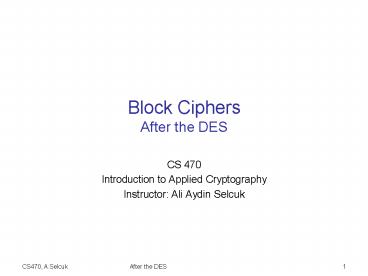Block Ciphers After the DES - PowerPoint PPT Presentation
Title:
Block Ciphers After the DES
Description:
Block Ciphers After the DES CS 470 Introduction to Applied Cryptography Instructor: Ali Aydin Selcuk After the DES DES was designed for h/w; slow in s/w. – PowerPoint PPT presentation
Number of Views:56
Avg rating:3.0/5.0
Title: Block Ciphers After the DES
1
Block CiphersAfter the DES
- CS 470
- Introduction to Applied Cryptography
- Instructor Ali Aydin Selcuk
2
After the DES
- DES was designed for h/w slow in s/w.
- It was also suspect, due to the secret design
process - By late 80s, need for an independently
developed, fast-in-s/w cipher was clear.
3
FEAL(Shimizu Miyaguchi, 1987)
- Idea More complicated f functionbut fast in
s/wwith fewer rounds hence higher speed. - Feistel cipher, originally 4 rounds. (later
increased to 6, 8, 16, 32) - Broken repeatedly
- 4 rounds with 5 known plaintexts
- 8 rounds with 12 chosen plaintexts
- 16 rounds with 228 chosen plaintexts
- 32 rounds may be adequately secure.
4
IDEA(Lai Massey, 1992)
- 64-bit block size, 128-bit key
- 8.5 rounds of
- ? bitwise XOR
- addition mod 216
- ? multpln mod 216 1
- decryption same as encryption, with inverse
keys - very secure, a bit slow (DES)
5
RC5(Rivest, 1994)
- Extremely simple flexible
- Variable block size (w), key size (b), no. of
rounds (r) specified as RC5-w/r/b. - Encryption algorithm
- L1 L0 K0
- R1 R0 K1
- for i 2 to 2r1 do
- Li Ri-1
- Ri ((Li-1 ? Ri-1) ltltlt Ri-1) Ki
- For 64-bit block size (w32), 24 rounds (r12) is
secure
6
Blowfish(Schneier, 1994)
- 16-round Feistel cipher with key-dependent,
large, variable s-boxes - variable s-boxes are not fixed targets for
analysis - with large (8x32) s-boxes, chances of a weak
combination is negligible - Simple, very fast f function. (s-box, , ?)
- x (x1,x2,x3,x4), where each xi is 8-bit.
- f(x) ((S1(x1) S2(x2)) ? S3(x3)) S4(x4)
- Slow key schedule.
7
Advanced Encryption Standard (AES)
- Successful public design process
- NISTs request for proposals (1997)
- 15 submissions (1998)
- 5 finalists (1999)
- Mars (IBM)
- RC6 (RSA)
- Twofish (Schneier et al.)
- Serpent (Anderson et al.)
- Rijndael (Daemen Rijmen)
- Winner Rijndael (2000)
8
Rijndael
- An SP cipher with algebraically designed s-boxes
(optimal against LC DC) - 128, 192, or 256-bit block size128, 192, or
256-bit key. - 10-14 rounds of
- ByteSub
- ShiftRow
- MixColumn
- AddRoundKey
- Decryption is similar to encryption (by design)
9
Rijndael Round Function
- Input is divided into 8-bit cells organized in 4
rows.Eg. for 128-bit block size - ByteSub Each cell goes through the s-box.
- ShiftRow Each of the 4 rows is shifted by a
different amount (diffusion) - MixColumn Every column, taken as a 4-entry
vector over GF(28), is multiplied by a special
4x4 matrix over GF(28). - AddRoundKey All cells are XORed by 8-bit keys.
X1,1 X1,2 X1,3 X1,4
X2,1 X2,2 X2,3 X2,4
X3,1 X3,2 X3,3 X3,4
X4,1 X4,2 X4,3 X4,4































